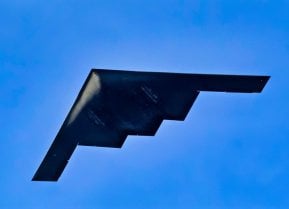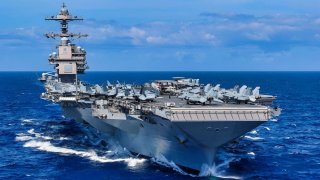F-35 Armed Ford-Class Aircraft Carrier John F. Kennedy Headed to Pacific
The USS John F. Kennedy (CV-67), the last conventionally-powered aircraft carrier built for the U.S. Navy, was decommissioned in 2007 after nearly 40 years of service, including key operations like the initial strikes in Operation Desert Storm. Succeeding it is the Gerald R. Ford-class nuclear-powered supercarrier CVN-79, named the future USS John F. Kennedy, set to enter service in 2025 and make its maiden deployment with the United States Pacific Fleet.
Summary: The USS John F. Kennedy (CV-67), the last conventionally-powered aircraft carrier built for the U.S. Navy, was decommissioned in 2007 after nearly 40 years of service, including key operations like the initial strikes in Operation Desert Storm. Succeeding it is the Gerald R. Ford-class nuclear-powered supercarrier CVN-79, named the future USS John F. Kennedy, set to enter service in 2025 and make its maiden deployment with the United States Pacific Fleet. Despite being a year behind schedule due to an altered Post-Shakedown Availability (PSA) strategy, the new carrier is 90% complete. This strategy aims to integrate necessary modifications and efficiency improvements learned from its predecessor, the USS Gerald R. Ford (CVN-78), including adaptations for the F-35C Lightning II and the upgraded Enterprise Air Surveillance Radar. This approach, endorsed by Congress, replaces the previously considered dual-phase delivery with a more capable single-phase delivery, ensuring the carrier's readiness for deployment to the Indo-Pacific, thereby bolstering U.S. naval deterrence in the region.
Next-Gen Power: The Future USS John F. Kennedy Set for Pacific Deployment
During her nearly 40 years, the Kitty Hawk -class variant aircraft carrier USS John F. Kennedy (CV-67) – the last conventionally-powered flattop built for the U.S. Navy – saw more than a dozen deployments to the Mediterranean and also commenced the very first strike operations against Iraqi forces as part of 1991's Operation Desert Storm.
Decommissioned in 2007, the now-retired warship will be succeeded by the Gerald R. Ford-class nuclear-powered supercarrier CVN-79, which was laid down in July 2015, and launched four years later. The future USS John F. Kennedy is now scheduled to enter service in 2025, but her initial deployment won't be in the same waters as the former carrier named for the 35th president of the United States.
Rather, it was announced last November that CVN-79 will become a unit of the United States Pacific Fleet when she makes her maiden deployment later this decade, Sea Power Magazine reported.
According to Captain Brian Metcalf, the U.S. Navy's program manager for the Ford-class aircraft carriers, following the commissioning and training workups, the nuclear-powered warship would make a deployment to the Indo-Pacific region and arrive at its new homeport on the U.S. West Coast. Metcalf made the comments while speaking at a panel of the American Society of Naval Engineers' Technology Systems and Ships seminar in November.
Metcalf also reaffirmed that the future USS John F. Kennedy was 90% complete at HII's Newport News shipyard, adding that the program office plans to complete much of the vessel's Post-Shakedown Availability (PSA) work would be completed on during the construction and before commissioning, would enable the Kennedy to enter its basic training phase on time.
USS John F. Kennedy Aircraft Carrier: Behind Schedule – But Still Coming
The second nuclear-powered carrier of the Ford-class is currently about a year behind schedule according to Fiscal Year 2024 (FY24) budget documents released a year ago. The delays were due to the altered PSA.
"The Navy is implementing a strategy to pull baseline work from the Post Shakedown Availability (PSA) into the construction period in order to provide more capability at ship delivery," the U.S. Navy's shipbuilding budget documents noted, USNI reported.
That revised schedule would ensure that CVN-79 would be ready to deploy to the Indo-Pacific when she enters service.
"This approach will prepare CVN 79 as the first FORD class aircraft carrier to operate in the Indo-Pacific region and decrease the amount of time CVN 79 would be required to be at the shipyard after ship delivery to conduct the PSA," the documents added. "CVN 79s PSA will align to a traditional period of resolving discrepancies discovered during trials. The revised strategy maintains the overall 'ready for deployment workups' milestone for CVN 79."
Dual Phase Delivery Scrapped
The sea service had decided to switch from a dual-phase delivery for the carrier to a single-phase delivery, which added two years of work to the flattop's detailed design and construction contract.
Initially, the U.S. Navy had employed the dual-phase to save money on construction schedules in the shipyard while avoiding significant overlap between USS John F. Kennedy entering the fleet and USS Nimitz (CVN-68) leaving. However, under the dual-phase approach, the Ford-class carrier would have received retroactive modifications for the carrier-based Lockheed Martin F-35C after delivery.
Instead, following a mandate from Congress, HII's Newport News Shipbuilding provided the modifications for the F-35C Lightning II during the vessel's construction, while other issues that were found during the construction of the lead vessel USS Gerald R. Ford (CVN-78) were also addressed. In addition, CVN-79 received the upgraded Enterprise Air Surveillance Radar.
"Shifting to single phase and incorporating the F-35C modifications will enable the delivery of a more capable and lethal carrier," said James Geurts, assistant secretary of the Navy for Research, Development and Acquisition. "Initiating this work now will build on the lessons learned from USS Gerald R. Ford to maintain the optimal construction timeline for the shipyard and to avoid inefficiencies."
Progress on the carrier continues, and it was last month that Newport News Shipbuilding began topside testing of the electromagnetic aircraft launch system (EMALS) on the carrier.
The U.S. Navy's newest nuclear-powered carrier, operating with the most advanced multirole fighter will be heading to the Indo-Pacific by the end of the decade – serving as a strong deterrent to China.
Author Experience and Expertise: Peter Suciu
Peter Suciu is a Michigan-based writer. He has contributed to more than four dozen magazines, newspapers, and websites with over 3,200 published pieces over a twenty-year career in journalism. He regularly writes about military hardware, firearms history, cybersecurity, politics, and international affairs. Peter is also a Contributing Writer for Forbes and Clearance Jobs. You can follow him on Twitter: @PeterSuciu. You can email the author: [email protected].


